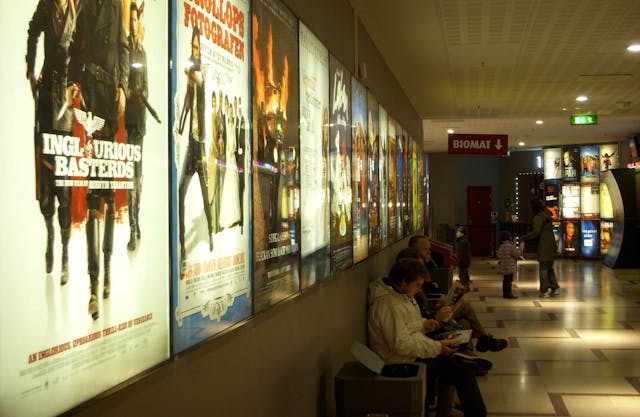Popflick Confidential: When Indie Movies Look Like Studio Films

Indie king: Matthew McConaughey's latest film got a SAG-AFTRA waiver to keep rolling during the strike / Photo by Dreamstime.
It’s Day 79 of the #WritersStrike and Day 7 of the @sagaftra strike. We stand with writers, actors, crew members, and every creative worker fighting for a livable wage.
Several independent productions applied for waivers and got the green light from SAG-AFTRA to keep the cameras rolling during the strike. Guild members from completed projects can engage in promotional events and media coverage. By now, the list includes 43 titles. Some are so early in the process they do not have an IMDB page. At least two are publicity magnets, that is, A24 projects: “Mother Mary,” directed by David Lowery and starring Anne Hathaway and Michaela Coel. The second one is “Death of a Unicorn,” with Paul Rudd and Jenna Ortega. You can also find “The Rivals of Amziah King,” with Matthew McConaughey, and the comedy “Bride Hard” with Rebel Wilson.

Hathaway: Why, yes! Of course I'm indie! / Photo courtesy of Dreamstime.
To see such high-profile names in an indie film production might raise eyebrows. The fact is that many begin their creative journey outside of the big studios that belong to the Alliance of Motion Picture and Television Producers (AMPTP). This trade organization represents studios and production companies. Their official website is bare, but if you go by the info on Wikipedia, they represent over 350 producers and media conglomerates like Amazon/MGM, Apple, Disney, NBCUniversal, Paramount/CBS, and Warner Bros.-Discovery. Talk about a David-versus-Goliath fight!
After completion, or at some point along the way, they might strike a deal with one of the big studios for distribution, which is why you get to see those recognizable logos on the screen. This is what happens at film festivals. The trades lap up news of studios and distributors engaging in millionaire bidding wars over a movie done for peanuts.
Still, it’s sobering to contemplate how even high-caliber stars are not necessarily cobbled by the studios, like the realization that most actors are not millionaires and must hold day jobs to cover their living expenses. If anything, the profession reflects society: a small percentage rakes in the big bucks, and the vast majority barely scrapes by.
Trailer Of The Day
We have a full trailer for “A Haunting in Venice,” Kenneth Branagh’s third and best adaptation of an Agatha Christie novel. Fans of the British mystery writer might be scratching their heads over the title, but this is not an unpublished work by the prolific writer. It’s “Hallowe’en’ Party,” originally published in 1969, transplanted to post-World War II Venice. In the book, the mystery hinges around a girl killed during a Halloween party after revealing she witnessed a murder some time ago. The party stops being fun when they find her drowned in a tub set up for an apple-bobbing contest.

Muder!: Brannagh directs himself as Hercule Poirot in "Death on the Nile" (2022) / Photo courtesy of 20th Century Fox.
The trailer shows Kelly Reilly as the mother of a dead girl who hires psychic Joyce Reynolds (Michelle Yeoh) to communicate with her daughter’s spirit. Tina Fey is novelist Ariadne Oliver, a friend of detective Hercule Poirot (Branagh), who brings him along to unmask the psychic as a fraud. How much of the original plot will remain? Will they use the ghastly infanticide as a backstory? Who knows! The cast includes Jamie Dornan and Camille Cottin.
The third time's the charm for Branagh's Poirot-verse. Or maybe this was more fun to me because I don't remember who the killer is (or who the killers are), as opposed to "Murder in the Orient Express" (2017) and "Death on the Nile" (2022). The previous movie got derailed by the pandemic shutdown, the flame-out of Armie Hammer's career, and the memes making fun of Gal Gadot's performance. "A Haunting in Venice" gets points for showing us Oscar-winner Michelle Yeoh is a proficient scream queen. The movie opens on September 15.
Fear-mongers have birthdays too
Two Japanese masters of horror share a birthday. There must be some scary movie idea behind that fact. Today, Kiyoshi Kurosawa is 68, and Hideo Nakata is 62,
Kurosawa scored a hit with “Cure” (1997), a spooky thriller about a serial killer with a murderous power of persuasion. With “Pulse” (2001), Kurosawa made a visionary film that anticipated how our lives would change with the advent of the online world. In the movie, a loose group of friends and coworkers get haunted by specters who reach them through computers, pushing them to suicide or oblivion. People disappear, leaving behind ashes. Nothing is quite explained, and that makes the movie even more unsettling. This is the stuff of classic horror films.

Kiyoshi Kurosawa: one of the top directors of the world, with a penchant for horror. / Photo courtesy of Dreamstime.
"Pulse" arrived propelled by the wave of J-Horror, jump-started towards the end of the nineties by Hideo Nakata's "Ringu" (1998). Based on a 1991 novel by Kaji Suzuki, The story feasts on the long tradition of vengeful spirits in Japanese literature and melds with our fascination - and dependency - on technology. Add a bit of end-of-the-century anxiety, and you end up with a trend that spawned franchises and remakes. None is scarier than the original movie, about a curse transmitted through viewing strange images via VHS tape. Once you see them, you get a phone call. Whoever is on the other side says, "Seven days." And seven days later, you die at the hands of a spectral girl who climbs out of your TV screen. The technology we made, the fruits of our rational intelligence, became tools of the un-rational, used to terrify and punish us for reasons unstated.

You did not rewind?: a cursed VHS tape is at the heart of Hideo Nakata's horror classic "Ringu" (1998). / Photo by Creative Commons.
In a nifty real-life twist that William Castle must have appreciated, "Ring" arrived in the transitional period when videocassettes slowly ceded space to DVDs but remained the most popular way to consume movies. Imagine renting "Ringu" for a weekend family viewing!
Of the two, only Kurosawa has managed to keep his international profile up, perhaps because he is more versatile. He kept mining fear with “Creepy” (2016), about a serial killer targeting families, but showed a facility with lyrical drama with the lovely “Tokyo Sonata” (2008), winner of the Un Certain Regard Jury Prize at the Cannes Film Festival. The made-for-tv spy thriller “Wife of a Spy” (2020) was exhibited theatrically outside Japan and won the Silver Lion for Best Director at the Venice Film Festival. Still, both directors should be embraced by movie buffs everywhere.
Max Fleischer is 140 years old
Walt Disney gets all the press now, but one can build a case for Max Fleischer as one of the pillars of modern American animation. The father of Betty Boop, Koko the Clown, and Bimbo the Dog was an immigrant from Poland. He invented rotoscoping energy. The technique allows you to recreate real-life movement in drawings - the guiding principle behind Richard Linklater's "Waking Life" (2001), "A Scanner Darkly" (2006), and "Apollo 10 1/2: A Space Age Childhood" (2022) -.
Through Fleischer Studios, he acquired the rights to “Popeye” and “Superman” to develop animated shorts. He was nominated for an Oscar for “Popeye the Sailor Meets Sindbad The Sailor” (1937). Disney stole his thunder by diversifying his business, exploiting ancillary products like toys and theme parks, and turning his name into a brand. Perhaps Fleischer was too comfortable under the Paramount umbrella or lacked the business drive of Disney, but his genius can’t be denied. He died in 1972.
Check out “Popeye the Sailor Meets Sindbad The Sailor” (1937), part of the Library of Congress Film Registry Collection.
True Indie Cinema
Step into the world of carefully selected independent films. Stream movies that will take you on a journey with a unique voice and bold storytelling. This is why we love independent movies.
Stream NowWant to get an email when we publish new content?
Subscribe today




























